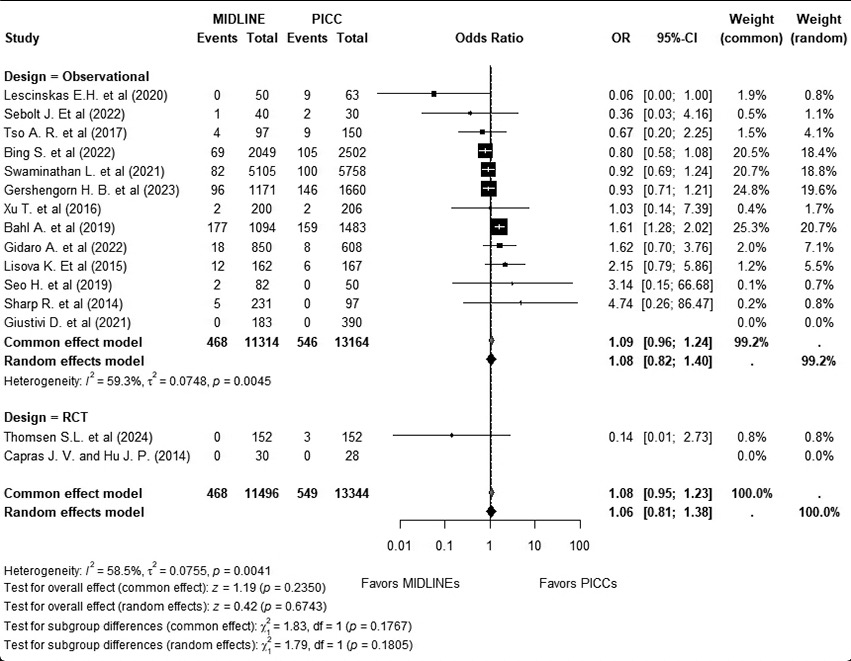Abstracts from the 29^ National Conference of the Italian Society for the Study of Hemostasis and Thrombosis, Bergamo, Italy | 23-25 October 2025
Vol. 4 No. s1 (2025)
PO15 | Venous thromboembolism risk associated with midline catheters and peripherally inserted central catheters: a systematic review and meta-analysis
D. Santagata1, F. Subri1, F. Dentali1,2, M.P. Donadini1, I. Giarretta2 | 1Department of Medicine and Surgery, Research Center on Thromboembolic Disorders and Antithrombotic Therapies, University of Insubria, Varese and Como; 2Department of Internal Medicine, Ospedale di Circolo and Fondazione Macchi, Varese, Italy
Publisher's note
All claims expressed in this article are solely those of the authors and do not necessarily represent those of their affiliated organizations, or those of the publisher, the editors and the reviewers. Any product that may be evaluated in this article or claim that may be made by its manufacturer is not guaranteed or endorsed by the publisher.
All claims expressed in this article are solely those of the authors and do not necessarily represent those of their affiliated organizations, or those of the publisher, the editors and the reviewers. Any product that may be evaluated in this article or claim that may be made by its manufacturer is not guaranteed or endorsed by the publisher.
Published: 22 October 2025
335
Views
0
Downloads
Similar Articles
- PO61 | ACTN1-related thrombocytopenia and severe hyperhomocysteinemia: a case report , Bleeding, Thrombosis and Vascular Biology: Vol. 4 No. s1 (2025)
- PO93 | Use of DOACS in heart transplantation recipients , Bleeding, Thrombosis and Vascular Biology: Vol. 4 No. s1 (2025)
- PO33 | Whole blood hypercoagulable profiles in patients with rheumatoid arthritis , Bleeding, Thrombosis and Vascular Biology: Vol. 4 No. s1 (2025)
- PO62 | Management of anticoagulation during extracorporeal circulation in a patient with APS , Bleeding, Thrombosis and Vascular Biology: Vol. 4 No. s1 (2025)
- PO94 | The use of antidepressant drugs and benzodiazepine hypnotics as an unusual risk factor for VTE , Bleeding, Thrombosis and Vascular Biology: Vol. 4 No. s1 (2025)
- PO34 | A negative oncologic follow up doesn’t always really mean no cancer: two case report of cancer-associated thrombotic microangiopathy , Bleeding, Thrombosis and Vascular Biology: Vol. 4 No. s1 (2025)
- PO63 | Atypical venous thrombosis in young patient with systemic lupus erythematosus and high-risk APL profile: provoked or not? , Bleeding, Thrombosis and Vascular Biology: Vol. 4 No. s1 (2025)
- PO95 | Idiopathic thrombocytopenic purpura in tuberculosis , Bleeding, Thrombosis and Vascular Biology: Vol. 4 No. s1 (2025)
- PO35 | Cerebral veins thrombosis in patients with and without myeloproliferative neoplasm: a real life retrospective monocentric study , Bleeding, Thrombosis and Vascular Biology: Vol. 4 No. s1 (2025)
- PO64 | A silent hemorrhage in the immuno-thrombotic chaos of antiphospholipid syndrome , Bleeding, Thrombosis and Vascular Biology: Vol. 4 No. s1 (2025)
1-10 of 96
Next
You may also start an advanced similarity search for this article.











